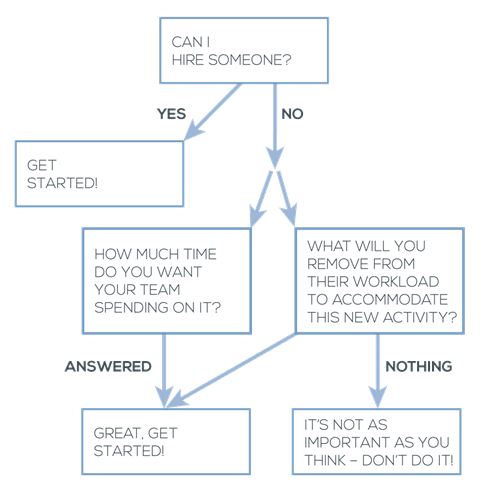Since the dawn of marketing, teams have been regularly sidetracked from solid strategic work to investigate if they "should be using [insert new shiny thing]."
In the late 2000s, social media was often the shiny object. Before that, it was the Web. If you go back far enough, television was the shiny object. Recently, "go-to-market" and "RevOps" became buzzwords.
Though all those tactics and channels have their place, doing something because it's new and trendy is not necessarily the best course of action for an organization.

Anyone can fall victim to shiny-object syndrome. In fact, at some point in our lives, we're almost all guilty of it.
In the context of B2B organizations, however, it is most damaging when senior team members are the culprits.
Marketing isn't the only department subject to such pressure, but because Marketing can and should be generating revenue for an organization, shiny-object syndrome can seriously derail company goals, and that can lead to team frustration, budget cuts, and even layoffs.
A Common Shiny-Object Syndrome Scenario
Your CEO goes to a conference that has a marketing track. The executive isn't happy with the results from the current marketing team or is just interested in bigger growth for the company. He or she hears a case study about how "new shiny marketing platform" increased company revenue by X%.
After the conference, the head of Marketing receives an email from the CEO: "Just got back from a conference. 'New shiny marketing platform' seems interesting. What are we doing with that?"
Panic sets in. The head of marketing goes into fire-drill mode to determine how to implement "new shiny marketing platform" without having first asked the CEO why.
The most important thing is to find out why the shiny object is being requested. Understanding the underlying reason for the request is critical. It may be that the executive has valid concerns about results, but that another solution is a better fit.
Is the Shiny Object Really for You?
Ask yourself the following questions:
- Does the shiny object help our strategy?
- Does our industry engage with this shiny object?
- Will this shiny object help or hurt our team goals?
- How hard is this shiny object to implement and maintain? What are the costs and benefits?
- Do we have the right team to support the shiny object?
- Can we afford to do so properly?
How to Stop Panic Marketing Because of Shiny-Object Syndrome
If you ask yourself the above questions and can make a case for the shiny object, then absolutely integrate the new tactic into your overall strategic plan. Marketing can and should be agile. But even if you think it's an interesting idea, you must determine how to implement it and how to measure it.
If you come across a shiny object and wonder whether you should implement it, use this flow chart as a guide.

If you ask yourself all the right questions and don't like the answers, you need a way to explain to leadership why the shiny object isn't right for the organization. You must build a case for either continuing down the current path or adjusting the path without the shiny object.
Your response to anyone asking for a shiny object that doesn't make sense should include...
- A reminder of the current goals and a validation that they are still correct
- An assessment of the current strategy and its effectiveness (If your current strategy isn't yielding the results that are expected, it doesn't mean that shiny object will fix the issue. Find the true issue and work to fix that!)
- An assessment of what the shiny object is and why it isn't a good fit (e.g., cost barriers, lack of expertise, not relevant to your target audience.)
As long as your marketing team members ask why they should implement the shiny object, they have a solid strategy aligned to company goals, and they can measure the effectiveness of what they're producing, shiny-object syndrome should be an easy hurdle to overcome.
Next: Avoiding the Pitfalls of Reactive Marketing
Missed Part 1? Read it here.
More Resources on Marketing Strategy and Shiny-Object Syndrome
Don't Give in to Marketing FOMO: Four Steps to Resisting Shiny-Object Syndrome




